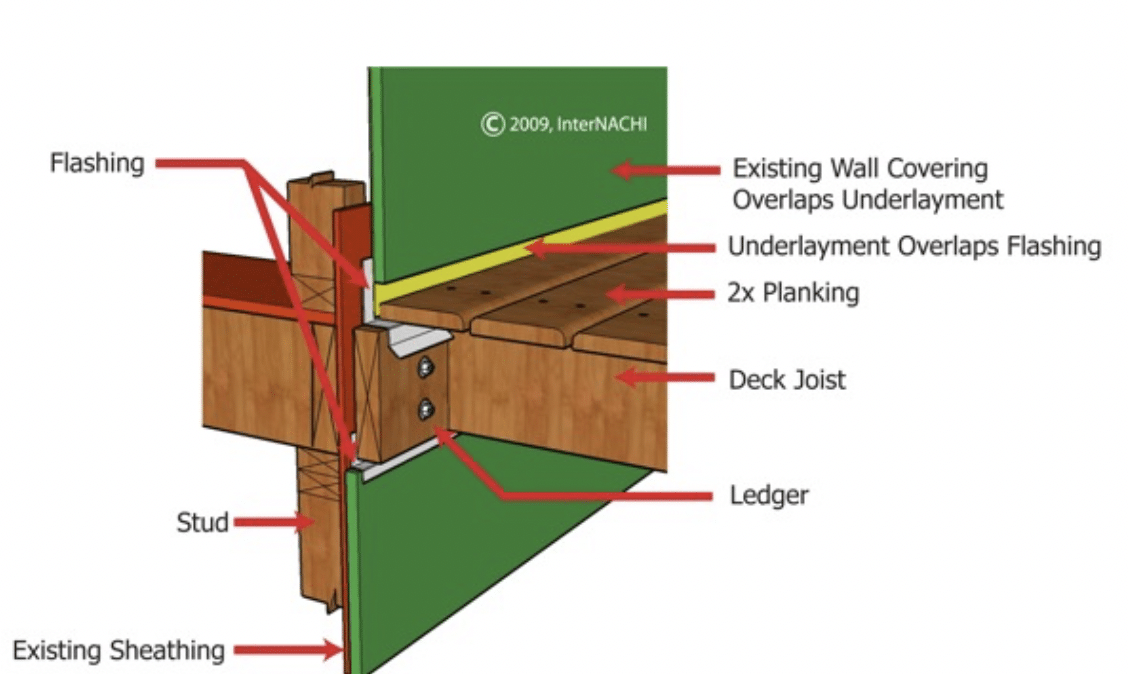
According to the Consumer Product Safety Commission (CPSC) an average of 6,000 people per year are injured because of a structural failure or collapse of a deck, porch, railing or staircase. The North American Deck and Railing Association estimates that 40% to 50% of the 40 million residential decks in the United States are not up to code or in danger of a collapse. If you’re purchasing a home with a deck attached it is important that the deck is inspected by a qualified professional prior to purchase.
According to International Association of Certified Home Inspectors (InterNACHI), about 90% of deck collapses occur as a result of the separation of the house and the deck ledger board, allowing the deck to detach from the house.
Up until 2003 it was acceptable to attach a deck directly to a house using only nails. However, after a tragic deck collapse in Chicago, a mandatory piece of material called the ledger board must be bolted to the house.

The most common cause of deck collapse is when a ledger pulls away from the band joists of homes and buildings.
Ledger Board Connections
The two most common ways to correctly attach a ledger to a structure are with lag screws or through-bolts. The installation of through-bolts requires access to the back-side of the rim joist which, in some cases, is not possible without significant removal of drywall within the structure.
Most building codes state that lag bolts or screws must be installed through the ledger board in a staggered pattern staggered from the top of the ledger board to the bottom of the ledger board in a horizontal pattern.
If a residence has siding, the siding must be removed in the area the ledger board will be attached to the house. Adding the ledger board over the siding can weaken the connection.
Ledger board can be attached to concrete or hollow masonry block as long as the builder follows local codes. A ledger board should never be attached to brick or stone veneer.

Ledger Board Flashing
Ledger flashing is intended to divert moisture away from the wooden components of the house. A deck ledger connection is only as strong as the wood it is attached to, and rotted wood is not very strong at all.
Ledger flashing is only required for decks attached to wood-frame construction. Since the ledger board is required to be decay resistant, the flashing is primarily to protect the house. The ledger board should be flashed even if the home has a protective roof overhang.
Aluminum flashing is commonly available but should not be used. Contact with pressure-treated wood or galvanized fasteners can lead to rapid corrosion of the aluminum.
Ledger boards attached to concrete foundations do not require this type of flashing, and a durable sealant is recommended in these applications.

According to Internachi most deck collapses occur due to an improperly secured ledger board. One of the big secrets to making sure your deck is safe is to inspect the ledger board for a proper connection. Also make sure that it is properly flashed. A properly flashed ledger board will prevent moisture from rotting the deck. Here is an Internachi video on proper ledger board flashing:
About the Author
Athena Deichman is the owner of Fidelity Home Inspections. She enjoys hanging out on her deck when the weather is just right. Fidelity Home Inspections proudly serves New Jersey!!! For further information call 609 337 6167 or check out our website www.fidelityhomeinspection.com We are NJ licensed and Internachi Certified Professional Inspectors.

Internachi
Information for this blog post was provided by Internachi, the International Association of Home Inspectors https://www.nachi.org

